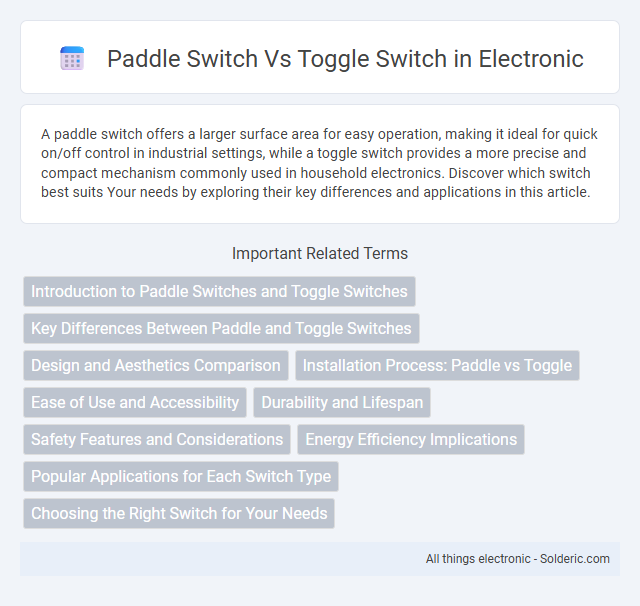A paddle switch offers a larger surface area for easy operation, making it ideal for quick on/off control in industrial settings, while a toggle switch provides a more precise and compact mechanism commonly used in household electronics. Discover which switch best suits Your needs by exploring their key differences and applications in this article.
Comparison Table
| Feature | Paddle Switch | Toggle Switch |
|---|---|---|
| Design | Flat, wide paddle for easy activation | Lever or handle that moves up/down or side to side |
| Operation | Pressed on large surface for ON/OFF control | Flipped or toggled between positions |
| Application | Common in lighting control, industrial machinery | Widely used in electronics, household devices |
| Durability | Robust, designed for frequent use | Standard durability, depends on build quality |
| Ergonomics | Ergonomic for quick, easy presses | Requires finger or thumb manipulation |
| Visual Feedback | May illuminate or show state clearly | Position indicates ON/OFF state |
| Installation | Usually flush-mounted on panels | Mounted via panel cutout, with nut fixing |
| Cost | Generally moderate price range | Varies; often lower cost options available |
Introduction to Paddle Switches and Toggle Switches
Paddle switches feature a wide, flat actuator designed for easy operation and enhanced visibility in industrial and commercial applications, while toggle switches utilize a small lever that moves up and down or side to side for compact and precise control. Paddle switches provide ergonomic benefits and are often used in environments requiring quick, reliable switching with minimal effort. Toggle switches are favored in electronics and automotive controls for their simplicity and robust mechanical feedback.
Key Differences Between Paddle and Toggle Switches
Paddle switches feature a wide, flat actuator that is easy to operate with a large surface area, making them ideal for quick on/off functions in industrial or commercial settings. Toggle switches, on the other hand, use a small lever that moves between fixed positions, providing tactile feedback and a classic design often preferred in residential or automotive applications. Your choice depends on the required user interface; paddle switches offer ergonomic ease while toggle switches provide precise control with a distinctive mechanical feel.
Design and Aesthetics Comparison
Paddle switches feature a wide, flat surface that offers a modern and sleek look, blending seamlessly with contemporary interior designs. Toggle switches have a classic, protruding lever that provides a retro or industrial aesthetic, often preferred in vintage or traditional settings. Your choice depends on whether you prioritize minimalist elegance with a paddle switch or timeless charm with a toggle switch.
Installation Process: Paddle vs Toggle
The installation process for paddle switches typically involves a standardized cutout size compatible with modern electrical boxes, allowing for straightforward mounting and wiring, often favored in commercial and residential settings. Toggle switch installation requires matching the mechanical toggle mechanism within the switch box, which may vary in size and shape, sometimes complicating replacement in older installations. Both switch types require proper wiring connections to the load and line terminals, but paddle switches often have easier-to-use screw or push-in terminals enhancing the installation efficiency.
Ease of Use and Accessibility
Paddle switches offer greater ease of use due to their large, flat surface, making them more accessible for individuals with limited dexterity or those wearing gloves. Toggle switches require precise finger movement and can be challenging for users with motor impairments or arthritis. In environments prioritizing quick, effortless operation, paddle switches enhance accessibility and reduce strain compared to the smaller, more tactile toggle switches.
Durability and Lifespan
Paddle switches offer enhanced durability due to their robust construction and larger surface area, making them less prone to wear from repeated use compared to toggle switches. Toggle switches, while reliable, often face mechanical fatigue faster because of their smaller actuator and higher stress on moving parts. Your choice for long-term applications should consider the paddle switch's superior lifespan, especially in high-traffic environments requiring frequent switching.
Safety Features and Considerations
Paddle switches offer enhanced safety features due to their larger surface area and flat design, which reduces accidental activation and provides better visibility in emergency situations compared to toggle switches. Toggle switches have smaller actuator profiles that are more prone to unintentional toggling, especially in tight spaces or during sudden movements. Your choice should consider the operational environment, as paddle switches are often preferred in industrial and commercial settings for their durability and ease of use under safety protocols.
Energy Efficiency Implications
Paddle switches typically consume less energy due to their low-resistance contacts and minimal mechanical movement, reducing power loss during operation. Toggle switches, while robust, may have higher contact resistance, potentially leading to increased energy dissipation over time. Selecting paddle switches can enhance overall energy efficiency in applications requiring frequent on/off cycles and precise control.
Popular Applications for Each Switch Type
Paddle switches are commonly used in automotive and industrial machinery due to their large surface area, which allows for easy activation even with gloves or wet hands, making them ideal for heavy-duty environments. Toggle switches are popular in residential and electronic devices where precise on/off control is required, often found in lighting fixtures, household appliances, and control panels. Your choice depends on the application's operational context, as paddle switches excel in rugged, high-traffic settings, while toggle switches provide reliable, tactile feedback for everyday use.
Choosing the Right Switch for Your Needs
Paddle switches offer a larger surface area for easy activation and are ideal for applications requiring quick, intuitive control, whereas toggle switches are compact and provide a distinct on/off position preferred for precision and reliability. Consider the switch's environment, usage frequency, and aesthetic preference to determine the best fit; paddle switches excel in automotive and industrial settings, while toggle switches are common in household appliances and electronics. Evaluating factors like switch durability, installation space, and tactile feedback ensures the chosen switch aligns with your operational requirements and user experience goals.
Paddle switch vs Toggle switch Infographic

 solderic.com
solderic.com